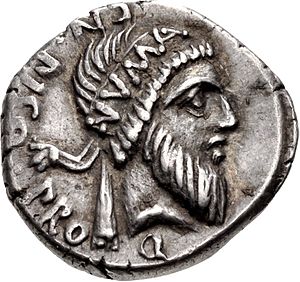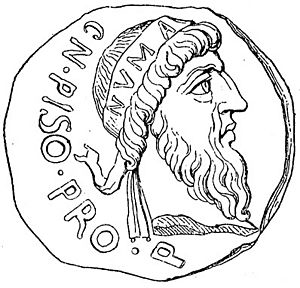Numa Pompilius facts for kids
Quick facts for kids Numa Pompilius |
|
|---|---|

Numa depicted on a 48 BC denarius
|
|
| King of Rome | |
| Reign | 715–672 BC |
| Predecessor | Romulus |
| Successor | Tullus Hostilius |
| Spouse | Tatia |
| Issue | Pompillia |
| Father | Pomponius |
Numa Pompilius (born around 753 BC, died 672 BC) was the second King of Rome. He took over after Romulus, following a one-year period without a king called an interregnum. Numa came from the Sabine people. Many important religious and government traditions in Rome started with him. These include the Roman calendar, the Vestal Virgins, and the role of pontifex maximus, who was the chief priest.
Contents
Numa's Early Life and Family
According to ancient writers like Plutarch, Numa was the youngest of four sons. He was born on the same day Rome was traditionally founded, April 21, 753 BC. Numa lived a very simple and disciplined life. He avoided anything fancy or luxurious.
Numa married Tatia, the only daughter of Titus Tatius. Titus Tatius was the king of the Sabines and had shared power with Romulus. After 13 years of marriage, Tatia passed away. Numa then moved to the countryside, living a quiet life. He lived in a place called Cures before he became king.
Some old stories said Numa learned philosophy from Pythagoras. However, historians like Titus Livius (Livy) and Plutarch didn't believe this. They said it didn't make sense for them to have met, given when and where they lived.
Numa had a daughter named Pompilia. Her mother was either Numa's first wife, Tatia, or his second wife, Lucretia. Pompilia later married Numa Marcius, who was the son of the first chief priest. Their son, Ancus Marcius, would later become a king of Rome.
Some writers also said Numa had five sons. These sons were Pompo, Pinus, Calpus, Mamercus, and Numa. Famous Roman families, like the Pomponii and Aemilii, claimed they were descended from these sons. However, Plutarch mentioned that some people thought these family stories were made up to make the families seem more important.
Becoming King of Rome
After Romulus died, Rome had no king for a year. During this time, members of the Roman Senate took turns ruling for five days each. In 715 BC, after much discussion between the Romans and the Sabines, they agreed on a new king. They chose Numa, who was about 40 years old and a Sabine.
At first, Numa didn't want to be king. He felt Rome was still a city of war, and he was a man of peace and thought. He believed Rome needed a military leader. But his father, his Sabine relatives, and two senators from Rome convinced him.
According to Livy and Plutarch, Numa was called to Rome. The people were very excited to welcome him. Before he accepted, Numa asked an augur (a religious official) to check if the gods approved. The signs from Jupiter were good. So, with the approval of both the people and the gods, Numa became King of Rome.
One of Numa's first actions was to get rid of Romulus's personal guard. This guard was called the "Swift" (celeres). This showed Numa's humility and his desire for peace.
Numa died of old age in 672 BC, after ruling for 43 years. He was about 81 years old. He asked to be buried in a stone coffin on the Janiculum hill, not cremated. Tullus Hostilius became the next king. Romulus was a king of war, but Numa was a king of peace. This meant Rome learned both how to fight and how to live peacefully.
Numa and the Gods

Romans respected Numa for his wisdom and strong religious beliefs. People believed he had a special connection with the gods. His most famous connection was with the nymph Egeria. Legend says she taught him how to be a wise ruler and create good laws.
Livy wrote that Numa claimed to meet with Egeria every night. She would tell him how to set up sacred rituals for the city. Numa then appointed priests for each god. Plutarch suggested Numa used these stories to inspire respect and encourage the early Romans to be more peaceful. He wanted them to honor the gods, follow laws, and live good lives.
Numa was also said to have written "sacred books." These books contained divine teachings, mostly from Egeria and the Muses. Plutarch and Livy say Numa asked to be buried with these books. He wanted the rules and rituals to be remembered by priests, not just kept in books.
About 400 years later (in 181 BC), some books were found in Numa's tomb. The Senate looked at them. They decided the books were not suitable for the public to read and had them burned. Some historians believe these books contained philosophical ideas that might have challenged Roman beliefs at the time.
Numa was also said to have convinced two minor gods, Picus and Faunus, to share prophecies about the future. He even had a clever talk with Jupiter himself to learn a ritual to protect against lightning.
Once, when a sickness was spreading, a brass shield called the Ancile fell from the sky. Numa said Egeria told him it was a gift from Jupiter to protect Rome. He ordered ceremonies to thank the gods, and the sickness ended. The Ancile became a sacred object, cared for by the Salii priests.
Important Roman Traditions Started by Numa
Numa created many important Roman institutions and religious practices.
Temple of Janus
One of Numa's first actions was building a temple of Janus. This temple showed whether Rome was at peace or war. Its doors were open during war and closed during peace. Numa made peace with Rome's neighbors, and the temple doors stayed closed for his entire reign. This was a very rare event in Roman history.
God of Boundaries
Numa also started the worship of Terminus, the god of boundaries. This involved sacrifices at property lines. Numa wanted Romans to respect private property and live peacefully with their neighbors. He taught that the god Terminus represented justice and peace.
Sacred Shields and Priests
Numa recognized how important the original Ancile shield was. He had eleven identical copies made. These were called the Ancilia, the sacred shields of Jupiter. Each year, the Salii priests carried them in a procession.
Numa also created the role of Pontifex Maximus, the chief priest. He also set up the priests for Romulus (called the flamen of Quirinus), in addition to those for Jupiter and Mars. Numa brought the Vestal Virgins to Rome from Alba Longa. These priestesses were very important.
Calendar Reform
Numa is also credited with changing the Roman calendar. He divided the year into twelve months based on the moon's cycles. He also adjusted it to match the sun's path. During his time, the months of January and February were added. Numa also decided which days were sacred and which were ordinary.
Other Religious Practices
Livy and Dionysius of Halicarnassus describe many other religious reforms by Numa. He established various priesthoods, like the curiones (who handled sacrifices), flamines (priests for specific gods), and augurs (who interpreted omens). He also set rules for sacrifices and prayers. For example, he said to offer an uneven number of victims to gods of the sky and an even number to underworld gods.
Numa is also linked to the ritual of the spolia opima. This was a special honor given to a Roman general who killed an enemy commander in single combat.
Ancient writers like Plutarch said that early Roman religion, under Numa, did not use images or statues of gods. They believed it was wrong to represent divine beings with perishable objects. They thought God could only be understood through the mind.
Some historians also believe Numa helped create early forms of "corporations." He saw that Rome was divided between Romans and Sabines. He thought it would be smart to divide them into smaller groups based on their jobs or trades. This helped bring people together.
The Story of Numa's Books
Livy tells a story about Numa's books. In 181 BC, about 500 years after Numa died, farmers were digging near the Janiculum hill. They found two stone chests. One chest was empty, but it said Numa Pompilius was buried there. The other chest had two bundles of seven books each. These books looked very new. Seven were in Latin and dealt with religious law. The other seven were in Greek and were about philosophy.
The books were shown to many people, and the discovery became public. A Roman official named Praetor Q. Petilius saw the books. He thought they were dangerous to Roman religion. He told the owner, L. Petilius, that he would burn them. The owner tried to get them back, but the case went to the Senate. The praetor swore an oath that the books were harmful. The Senate agreed and ordered the books to be burned immediately in the Roman Forum. The owner refused money for the books. The books were then burned.
Some scholars believe these books were real and contained philosophical ideas that might have been too different from traditional Roman beliefs at the time.
See also
 In Spanish: Numa Pompilio para niños
In Spanish: Numa Pompilio para niños
- Pompilia gens


